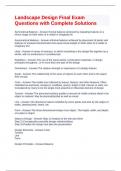Landscape Design Final Exam
Questions with Complete Solutions
Symmetrical Balance - Answer-Formal balance achieved by repeating features in a
mirror image on both sides of a visible or imaginary lin
Asymmetrical Balance - Answer-Informal balance achieved by placement of plants and
features of unequal characteristics but equal visual weight on both sides of a visible or
imaginary line
Unity - Answer-A sense of oneness, in which everything in the design fits together as a
whole, with no extraneous or unrelated par
Repetition - Answer-The use of the same plants, construction materials, or design
principles throughout , or in more than one part of the design
Dominance - Answer-The relative strength or importance of a design feature
Scale - Answer-The relationship of the sizes of objects to each other and to the space
they occupy
Color - Answer-The visible hue reflected by leaves, flowers, and other features. Often
classified as warm(red, orange) or cool(blue, green), bright or dull, intense or calm, etc.
Considered by many to be the single most powerful or influential element of design
Texture - Answer-The perceived surface quality or amount of visible surface detail of an
object or material. May be physical(tactile) as well as visual
Line - Answer-The directional nature exhibited by some plants and also by the edges of
walks, planting beds, lawns, etc.
Form - Answer-The three dimensional shape of an object. The height, width, and depth,
of a plant or object
Steps to Design - Answer-Step 1) Analysis of the site and client
Step 2) Conceptualize possible design solutions/ideas
Step 3) Finalize the design and plan the presentation
Design Elements - Answer-Color
Texture
Line
Form
Design Principles - Answer-Balance
, Unity
Repetition
Dominance
Scale
Landscape Architect- - Answer-A formally trained professional qualified to plan
landscapes and public use areas of all types. In most areas, the use of the title is
restricted by law to licensed individual
Site analysis- - Answer-Step by step process involving collecting all relevant information
about your site information about your site
Results in A plan drawing which evaluates the problems and opportunities of the site
and gives general information and recommendations. Notes and labels should point out
characteristics of the site such as: lack of privacy, need for windbreak, lawn needs
renovation due to soil compaction, wider entry walk needed, maintain good view
Landscape Designer- - Answer-A person with a strong background in horticulture,
landscape design, construction, and graphics, who provides designs for single-family
residential landscapes. Not a licensed title,
Site inventory- - Answer-A plan drawing depicting all pertinent existing site
features.Including information about climate, soil, structures and paving, existing plants,
utilities, off-site views, traffic and activity patterns, affect of neighboring properties, etc
Design Process- - Answer-A step by step procedure which takes a problem solving
approach to landscape design. Views the project as a whole from the start and follows
through each step in sequence
Biennials - Answer-plants that bloom for 2 years then needs to be reseeded
annuals - Answer-plants that bloom every year, don't need to reseed every year.
perennials - Answer-plants that only last a year, then need to reseed
Deciduous trees - Answer-trees that lose their leaves every fall/winter
Coniferous trees - Answer-Trees with needles for leaves
Evergreen trees - Answer-Trees that keep their leaves year round
Landform - Answer-different shapes of land, like hills, valleys, etc.
Berm - Answer-raised mound in soil,
adds interest, directs water
swale - Answer-low area that carries water away




